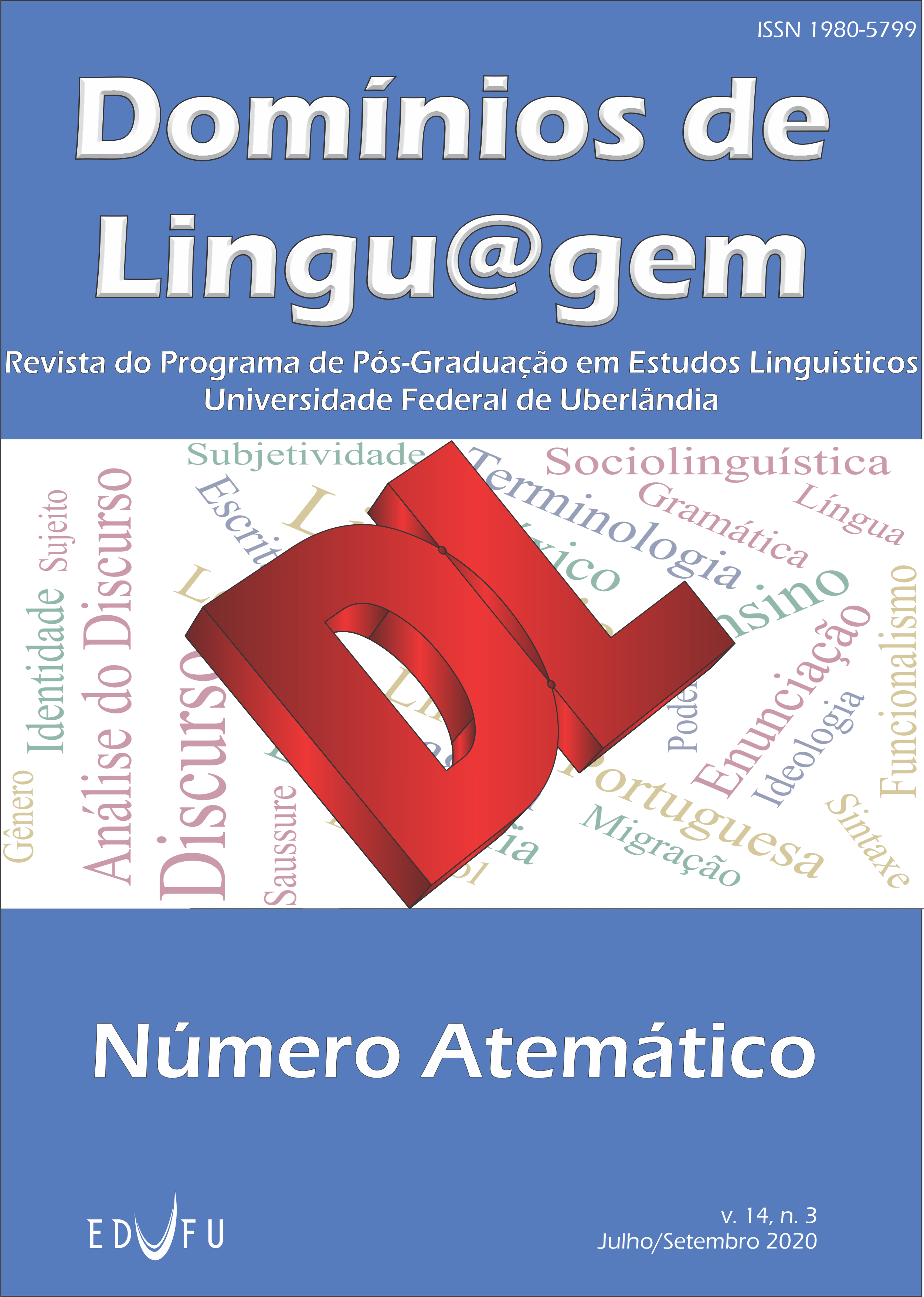Digital genres and literacy
proposals with comics
DOI:
https://doi.org/10.14393/DL43-v14n3a2020-2Keywords:
Comic books, Literacy, Digital genresAbstract
This paper seeks to reflect on the teaching of text production in literacy based on work with digital textual genres. Specifically, it attempts to demonstrate how comic-book genres, transmuted or produced in digital software, can be worked on as objects of language teaching and learning in literacy classes. For this, it finds support in notion of genre by Bakhtin (1992, 2006), in the discussion about the genres of comic books by Mendonça (2005), Vergueiro (2009, 2014) and Ramos (2009), besides studies by Koch ( 1998), Marcuschi (2008) and Silva (2018) dealing with the teaching of text production. Methodologically, this is a research which approach is qualitative, with descriptive bias. Finally, the productivity of proposals with the gender discussed is emphasized.
Downloads
Metrics
References
BAKHTIN, M. M. Estética da Criação Verbal. Tradução do russo por Paulo Bezerra. 4ed. São Paulo: Martins Fontes, 1992.
BAKHTIN, M. M. Marxismo e filosofia da linguagem: problemas fundamentais do método sociológico da linguagem. São Paulo: Hucitec, 2006.
BRANDÃO, A. C. P.; LEAL, T. F. Alfabetizar e letrar na Educação Infantil: o que isso significa? In: BRANDÃO, A. C. P.; ROSA, E. C. S. (org.). Ler e escrever na Educação Infantil: Discutindo práticas pedagógicas. Belo Horizonte: Autêntica, 2005.
CRYSTAL, D. A revolução da linguagem. Rio de Janeiro: Jorge Zahar Edições, 2001.
KOCH, I. G. V. O texto e a construção dos sentidos. 2 ed. São Paulo: Contexto, 1998.
MARCUSCHI, L. A. Produção textual, análise de gêneros e compreensão. São Paulo: Parábola Editorial, 2008.
MENDONÇA, M. R. S. Um gênero quadro a quadro: a história em quadrinhos. In: DIONÍSIO, Â. P.; MACHADO, R. A.; BEZERRA, M. A. (org.). Gêneros textuais & ensino. 4. ed. Rio de Janeiro: Lucena, 2005.
MORETTI, F. Qual a diferença entre charge, Cartum e quadrinhos? Disponível em: http://oblogderedacao.blogspot.com/2013/01/qual-diferenca-entre-charge-cartoons-e.html. Publicado em junho/2001. Acesso em: 02 dezembro/2018.
NEVES, M. H. M. A Gramática: Conhecimento e Ensino. São Paulo: UNESP, 2000.
RAMOS, P. A leitura dos quadrinhos. São Paulo: Contexto, 2009.
SANTOS, R. E. Para Reler os Quadrinhos Disney: Linguagem, evolução e análise de HQs. São Paulo: Paulinas, 2002.
SANTOS, R. E.; VERGUEIRO, W. Histórias em quadrinhos no processo de aprendizado: da teoria à prática. EccoS – Revista Científica. São Paulo, n. 27, p. 81-95, jan./abr. 2012. DOI https://doi.org/10.5585/eccos.n27.3498
SMOLKA, A. L. B. A criança na fase inicial da escrita: a alfabetização como processo discursivo. 14. ed. São Paulo: Cortez, 2010.
SILVA, A. A. Linguística Textual e Ensino: coesão e coerência na alfabetização. Claraboia, Jacarezinho, Paraná, v.10, jul./dez., p. 95-118.
VERGUEIRO, W. Quadrinhos e educação popular no Brasil: considerações à luz de algumas produções nacionais. In: VERGUEIRO, W.; RAMOS, P. (org.). Muito além dos quadrinhos: análises e reflexões sobre a 9ª Arte. São Paulo: Devir, 2009. p. 83-102.
VERGUEIRO, W.; RAMOS, P. (org.). Quadrinhos na educação: da rejeição à prática. São Paulo: Contexto, 2009.
VERGUEIRO, W. Uso das HQS no ensino. In: RAMA, Â.; VERGUEIRO, W. (org.). Como usar as histórias em quadrinhos em sala de aula. São Paulo: Contexto, 2014. p. 7-30.
Downloads
Published
How to Cite
Issue
Section
License
Authors who publish in this journal agree to the following terms:
Authors retain the copyright and waiver the journal the right of first publication, with the work simultaneously licensed under the Creative Commons Attribution License (CC BY-NC-ND 4.0), allowing the sharing of work with authorship recognition and preventing its commercial use.
Authors are authorized to take additional contracts separately, for non-exclusive distribution of the version of the work published in this journal (publish in institutional repository or as a book chapter), with acknowledgment of authorship and initial publication in this journal.









